Air quality solutions post coronavirus lockdown
by Vidhya Sreenivasan
65 Minute Read
Second in a three-part series on the coronavirus lockdown’s effect on the environment, and what we can learn from it.
In our previous article, we outlined the remarkable difference that the COVID-19 response has made to the air quality in Indian metropolitan cities.
We saw that just one week of lockdown had brought about a difference of nearly 20% in the values of particulate matter (PM10 and PM2.5). It is, of course, unreasonable to either rejoice at this situation or to think or want it to last forever.
The numbers simply serve to remind us of the cost of economic activity on our health.
So what should we expect to see as the world and India come out of this situation? Since the benefits of clean air are of little value in an economic slump, it is common knowledge that we need to strive for the right balance.
In this article, we will address how Pure Skies is able to improve air quality as much as what was seen during the coronavirus lockdown. Without any detriment to the economy.
Technology at play
There is no dispute that any air quality plan should start at source reduction and policy implementation. With that in mind, the Ministry of Environment, Forests, and Climate Change of India (MoEFCC) launched the National Clean Air Programme (NCAP) in January 2019 setting a national target of 20 – 30% reduction of PM2.5 and PM10 by 2024.
Taking the example of Delhi, where the average annual PM2.5 levels are around 115 µg/m3 (as of 2018). A 30% reduction would bring average PM2.5 to 80 µg/m3. This is still way higher than the Indian standard of 60 µg/m3 and the WHO guideline of 25 µg/m3.
That’s where technology such as Pure Skies can play a role - to supplement mitigation efforts and ensure clean air.
In this article, we present some on-the-ground data of air quality improvements achieved by Pure Skies – a technology that uses electromagnetic waves to reduce particulate pollution.
The numbers are clear!
We analyzed two sets of data – one from the CPCB monitors at Delhi and the other from a CPCB monitor at Kolkata. While the former was analyzed before and after lockdown (Figure 1), the impact of Pure Skies on air quality was analysed in Kolkata (Figure 2). We installed 4 Pure Skies units to cover an area of approximately 14 sq. km in the city of Kolkata. We compared the air quality within this area with the air quality outside of this area during the same time period. Here is what we found.
During the lockdown, the average PM2.5 in Delhi reduced by 56%. In comparison, average PM2.5 in one area in Kolkata (where Pure Skies was installed in 12/2019) reduced by 53% when compared to the rest of Kolkata during the same period!
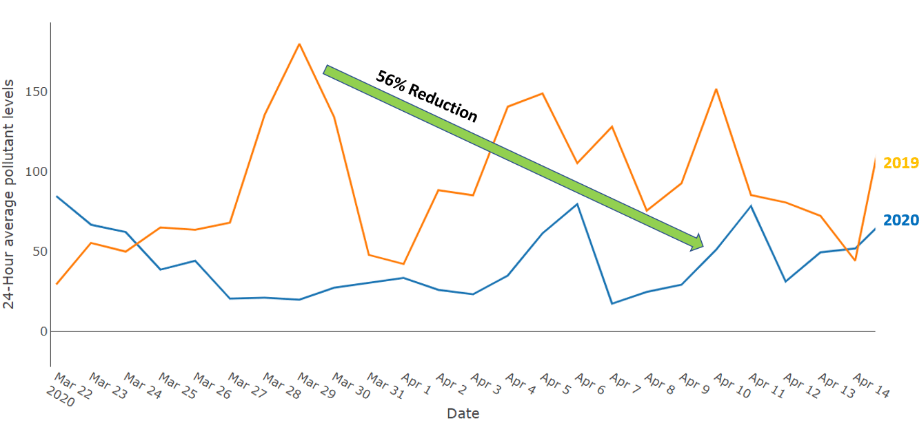
Figure 1. Reduction of 24-hour average PM2.5 levels in Delhi during the 21-day lockdown (blue line) vs. the same time period in 2019 (orange line). Average PM2.5 has reduced by 56% (data source: CPCB reference monitors)
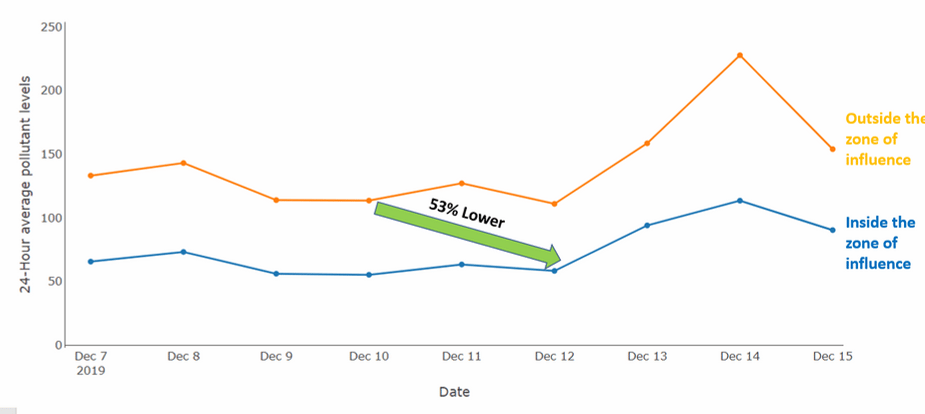
Figure 2. PM2.5 levels where Pure Skies was installed (blue line) vs PM2.5 levels in the rest of the city (orange line). There is a 53% improvement in PM2.5 levels within the zone of influence of Pure Skies (data source: CPCB reference monitors)
We also compared the Delhi data with another location in the Delhi region – a manufacturing facility in Faridabad. The reduction in PM2.5 with Pure Skies was 60% over a span of 3.5 months under regular manufacturing conditions (Figure 3).
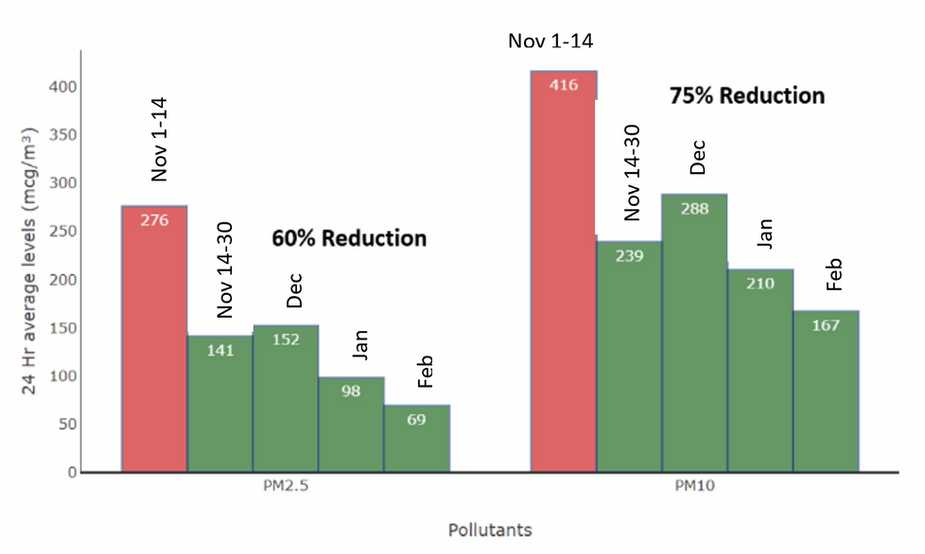
Figure 3. Reduction of PM2.5 and PM10 inside a manufacturing facility in Faridabad (outside Delhi). The red bar represents a baseline period before Pure Skies was installed. Subsequent green bars represent air quality once Pure Skies was installed over 3½ months. There was an overall reduction in 24-hour average levels of PM2.5 (left) and PM10 (right) by 60% and 75%, respectively, during this period. Production levels remained stable throughout (Data source: third party air quality monitors)
In essence, what we saw was that Pure Skies achieved similar same reductions in particulate matter as those we saw during the lockdown, without any detrimental effect on the economy!
PM10 has shown equally compelling reductions, both in Kolkata as well as Faridabad, as can be seen in the graphical representations below.
That is very telling on the potential of technology to save human lives.
.webp?width=925&name=412758_887b937b62964aeea6f014c5a1699f71_mv2%20(1).webp)
Figure 4. Reduction of 24-hour average PM10 levels in Delhi during the 21-day lockdown vs. the same time period in 2019 (data source: CPCB reference monitors).
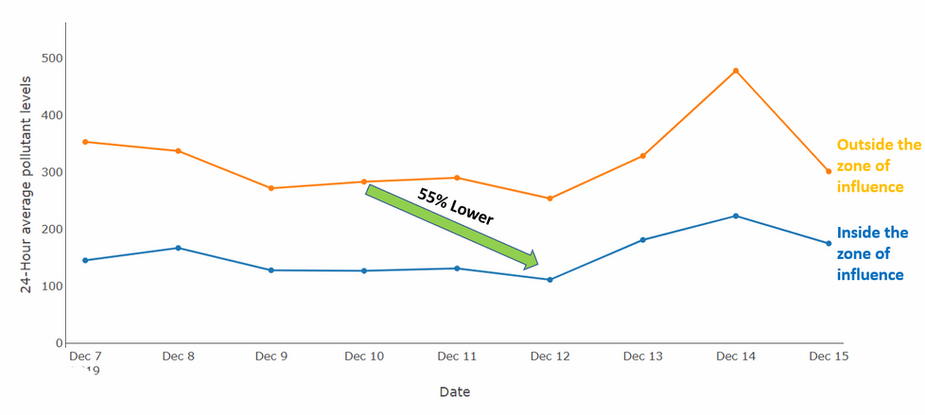
Figure 5. PM10 levels where Pure Skies was installed vs. PM2.5 levels in the rest of the city (data source: CPCB reference monitors)
So what?
We now remember what clean air feels like.
Now, think about this for a minute:
What if we can achieve similar air quality as we have seen during the lockdown even as we ease out of this situation? What if we can finally breathe freely? What if we can lead a healthier life?
We believe Pure Skies is a strong contender in this space and holds great promise in achieving improvements in air quality.
What is Pure Skies?
As the name implies, Pure Skies is a state-of-the-art technology that uses electromagnetic waves to reduce particulate matter in ambient air. The technology is the brainchild of Devic-Earth, which is based in Bangalore. The technology works by using pulsed radio waves in the Wi-Fi spectrum to accelerate dry deposition of PM2.5 and PM10. A two-year-old company, Devic-Earth has about 50 Pure Skies installations across India.
In our next blog in this series, we will explore some of the policy decisions that would help in addressing air quality in a more sustainable manner. We have seen what it feels like – are we ready to take action to keep it this way even past the COVID-19 response?
In the next blog, we will look at some policy outcomes that can come out of this understanding.

.svg)
.webp?width=1080&height=1080&name=Free%20Case%20Study%20Steel%20Plant%20(1).webp)
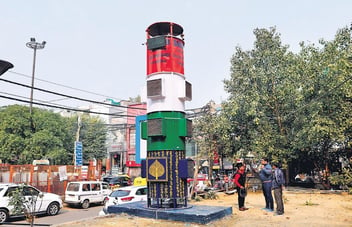
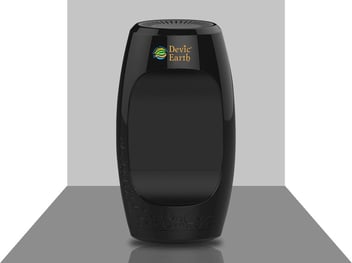




Post Comments